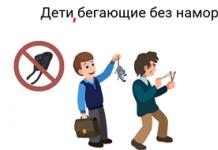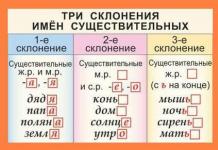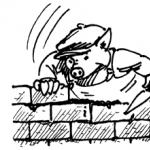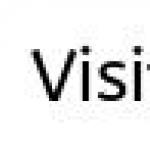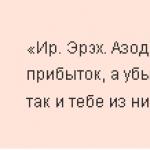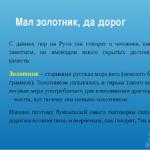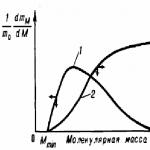Punctuation- This:
- Punctuation system
- A branch of linguistics that studies punctuation marks and the rules for their use in writing
Punctuation rule
Punctuation rule- this is an instruction that indicates the conditions for choosing a punctuation mark (i.e., its use or non-use). The conditions for choosing a punctuation mark are the grammatical, semantic and intonation features of sentences and their parts.
Note.
The place in the sentence where punctuation is necessary can be found by identifying features (signs). Identification signs of the use of punctuation rules:
- morphological: the presence of participles, gerunds, interjections, conjunctions, individual particles;
- syntactic: the presence of two or more grammatical stems, addresses, new words, isolated members of a sentence, homogeneous members, foreign speech;
- sound: pronunciation with vocative and other types of intonations;
- semantic: expression of reason, etc.
Functions of punctuation marks
Punctuation marks serve to separate sentences from each other in the text, to separate and highlight semantic segments in a sentence. They are divided into three groups: separating(in the text), dividing And excretory(in a sentence).
Separating punctuation marks
These include period, question mark, exclamation mark, ellipsis. They are used:
- to separate each word of a sentence from the next one in the text;
- to design a separate sentence as complete.
Punctuation at the end of a sentence
Rules:
- A period is put at the end of narrative and incentive sentences if they do not additionally express emotions (feelings).
- At the end of interrogative sentences there is a question mark.
- An exclamation mark is placed at the end of any sentence based on the purpose of the statement if they additionally express a feeling.
- An ellipsis is placed at the end of a sentence if the writer takes a long pause.
Punctuation marks
These include comma, semicolon, dash, colon. Separating punctuation marks serve in a simple sentence to indicate boundaries between homogeneous members (commas and semicolons), in a complex sentence - to separate simple sentences included in its composition.
The choice of dividing punctuation marks is determined by morphological, syntactic, semantic and intonation conditions.
Distinctive punctuation marks
Distinctive punctuation marks serve to indicate the boundaries of semantic segments that complicate a simple sentence (addresses, introductory words, phrases, sentences, isolated secondary members), as well as direct speech.
Distinctive punctuation marks are a comma (two commas); dash (two dashes); Exclamation point; double brackets; colon and dash used together; double quotes.
The choice of punctuation marks is determined by syntactic, semantic and intonation conditions.
Cases when punctuation is not used
- Between the subject and the predicate, which is joined by a conjunction How.
- Between homogeneous members connected by single unions and, or.
- Before application, if union How used in the meaning " as».
- After the participial phrase, if it comes before the defined noun and does not have a causal meaning.
- Before adverbs formed from gerunds.
- Between simple sentences in a complex sentence with a conjunction And in the presence of a common member.
- Between homogeneous subordinate clauses connected by a conjunction And.
- Between agreed upon definitions, if they characterize the subject from different angles.
INTRODUCTION
Punctuation marks are a necessary element of the written form of Russian speech. A modern test cannot be recorded without punctuation marks and cannot be reproduced normally. Punctuation marks provide the writer and reader with an unambiguous understanding of the sentence and text.
The purpose of punctuation marks is to convey the syntactic and semantic division of the text, as well as the main structural features of the intonation of the sentence. The transfer of intonation structure is not an end in itself; its elements insofar as they participate in the syntactic and semantic division of the text. Modern punctuation reflects structure, meaning and intonation. Written speech is organized quite clearly, definitely and at the same time expressively. As a rule, the intonation principle is reduced to the semantic, semantic to the structural.
Sometimes punctuation marks act as duplicate indicators of division in the presence of special linguistic means - conjunctions, allied words, as well as connective particles. The use of punctuation marks is governed by rules that are mandatory and identical for all speakers and writers.
The following punctuation marks are used in Russian punctuation: period, question mark, exclamation point, ellipsis, comma, semicolon, colon, dash, parentheses, quotation marks. The function of a punctuation mark is also performed by paragraph indentation, or a red line.
Punctuation marks in the modern punctuation system of the Russian language have functions assigned to them. They either separate parts of the text from each other, or highlight any segments within parts.
In accordance with this, there are two main functions of punctuation marks:
- departments;
- discharge.
These functions are often complicated by more specific, semantic-distinguishing functions.
The main functions of all punctuation marks, as well as their semantic distinguishing functions, are described in the set of rules of Russian punctuation.
1. PUNCTION MARKS WITH A SEPARATING FUNCTION
The separating marks are period, exclamation and question marks, semicolon, colon, ellipsis, paragraph (in this case the term is used to mean paragraph indentation).
Separating punctuation marks divide written text into semantically and grammatically significant parts. Close functionally are the symbols comma (separator), semicolon, period. Their difference is often only “quantitative”: they record pauses of varying degrees of duration. In terms of semantics, the parts divided by commas and semicolons are less independent; they represent segments within one sentence; The dot denotes the completeness of the thought. These signs are used when listing syntactically equivalent parts of the text: members of a sentence, parts of a sentence (comma and semicolon), individual sentences (period). For example, a comma:
between homogeneous members: And here a fresh wind blows, smelling of the river, resin, the mysterious spirit of damp wood... (Yu.P. Kazakov);
between parts of a complex sentence: New troops approached and loaded into boats, ferries sailed with carts of hay and all sorts of military goods (A.N. Tolstoy);
between homogeneous subordinate clauses: Yes, the prince did not know where Katenka was, what happened to her after he left (A.N. Tolstoy).
Features of the use of semicolons are associated with its graphic originality. Being a connection of a period and a comma, it is used as a sign, as it were, “intermediate” between them. A semicolon is used, on the one hand, to simply more clearly, more noticeably indicate the boundary between very common components of a sentence, within which there are other punctuation marks (The fence, going around the hut and the courtyard on both sides, ran down to the water where the willows grew; one stood with with its top cut off, many branches sticking out in its place, the other bent low over a narrow river (A.N. Tolstoy)); on the other hand, to emphasize the relative semantic independence of the units (There were no passers-by; the windows of the palace were dark; the sentry at the entrance stood motionless, wrapped in a sheepskin coat, with a gun stuck to his side (A.N. Tolstoy)).
The qualitative similarity of the listed signs is easily understood by comparing examples designed differently:
1) The crowd suddenly rushed forward and separated us. Hats and caps flew into the air. A furious “hurray” exploded near the podium. (K.G. Paustovsky).
2) The crowd suddenly rushed forward and separated us, hats and caps flew into the air, a frantic “hurray” exploded near the podium.
3) The crowd suddenly rushed forward and separated us; hats and caps flew into the air; a frantic “hurray” exploded around us.
The general functional significance of these signs and at the same time their difference in the degree of text division they indicate make it possible to use them in complex sentences as a certain gradation system. For example: Fences ran across the cleared area, stacks and haystacks began to appear, small smoky yurts grew; finally, like a victory banner, on a hill from the middle of the village a bell tower shot to the sky (V.G. Korolenko) - in this non-union complex sentence there are four syntactically equivalent parts, but the first three are separated by commas, and the fourth is separated by a semicolon; This arrangement of signs makes it possible, firstly, to emphasize the greater semantic cohesion of the first three parts of the sentence and, secondly, the isolation and semantic independence of the fourth part of the sentence. In addition, such signs are justified from the point of view of the structural organization of the sentence: the first three have a common member that unites them into a single whole - in a cleared place, and in the fourth part there is an introductory word, and finally, its attribution to this part of the sentence is only possible when there is a semicolon separating the preceding part of the text.
A single comma, like a semicolon, always stands between syntactically equivalent parts of text or word forms that are equivalent in syntactic function.
2. PUNCTION MARKS WITH EXCELLENT FUNCTION
Emphasis marks include brackets and quotation marks, commas and dashes when used in pairs. In this case, parentheses and quotation marks are invariably used in pairs. The remaining punctuation marks are used on both sides of the highlighted component if it is located in the middle of the sentence.
If it is at the beginning or end of a sentence, then a comma, a dash or (sometimes) a combination of a comma and a dash are used once - after the highlighted phrase or before it. For example, the use of commas that highlight separate phrases at the beginning and end of a sentence: Looking at the clouds, I remembered all the last days spent on the schooner (Kazakov).
Their purpose is to highlight particularly significant parts of a sentence; Such commas are used for isolation, for highlighting addresses, introductory constructions, and interjections.
The most common punctuation mark is the comma - the most “neutral” among other marks used in the middle of a sentence. Emphatic commas sharply diverge in function from periods and semicolons; in this case, they are included in a different system of punctuation meanings, those that are characteristic of emphases, in particular the paired dash and parentheses. For example:
- commas for isolation: I spent the night somewhere on the outskirts, in a penny hotel, and left Sevastopol early in the morning (I.A. Bunin);
commas for introductory words and introductory sentences: Yesterday, they say, someone’s hunt passed us along the high road to the outgoing field, along with the hunt of young Tolstoys (I.A. Bunin);
- commas when addressing: Indeed, Petya, tell the singer, let him serve the samovar (Gorky);
- commas highlighting subordinate clauses: Some who stood closer reluctantly pulled off their hats (A.N. Tolstoy);
Here there is a new gradation: commas, dashes, parentheses (commas highlight parts of the sentence that are less significant and complex; dashes - parts that are more significant and common; parentheses - especially sharply exclude parts from the composition of the sentence). For example, the use of emphases and parentheses, commas and dashes, dashes and parentheses:
1) The lower part of the face protruded somewhat forward, revealing the ardor of a passionate nature, but the tramp (based on some characteristic, although difficult to discern, signs, I immediately assumed that my guest was a tramp) had long been accustomed to restraining this ardor (V.G. Korolenko);
2) Nowhere in all of Russia - and I have traveled quite a bit in all directions - have I not listened to such deep, complete, perfect silence as in Balaklava (K.G. Paustovsky);
3) He became sad, taciturn, and the external traces of Baku life - premature old age - remained with Green forever (K.G. Paustovsky).
The distinctive role of such signs is especially clearly revealed when they are interchangeable. For example: Kutuzov listened to the report of the general on duty (the main subject of which was criticism of the position under Tsarev-Zaimishche) just as he listened to Denisov (L.N. Tolstoy). -Kutuzov listened to the report of the general on duty, the main subject of which was criticism of the position under Tsarev-Zaimishche, also...
The fact that parentheses are the most powerful disabling sign in comparison with commas and even dashes is confirmed by the possibility of using them not only inside sentences, but also in paragraphs. As an emphatic mark, they are used in syntactic units larger than a sentence. For example: Eight minutes to five. All the cadets are ready, dressed up for the ball. (“What a stupid word,” thinks Alexandrov, ““dressed up.” It’s as if they dressed us up in Spanish costumes.”) The gloves were washed and dried by the fireplace (A.I. Kuprin).
Quotation marks also serve as emphasis. The quotation marks are:
- quotes;
- direct speech. For example: They asked him [Cherdakov]: “Valka, is it true that they say that in 1916 you shot down a German ace, the next day you flew to Germany and dropped roses on his grave?” He answered in a squeaky voice: “Well, what?” (A.N. Tolstoy). Moreover, if the character’s thoughts are given in the form of direct speech, then quotation marks are the only possible sign. For example, Holding back my sighs, I thought: “Here, you meet a person and pass by absentmindedly, and he is in front of you, like a whole kingdom in smoking ruins...” (A.N. Tolstoy)
- words that are not used in their usual meaning; words used ironically; words proposed for the first time or, conversely, outdated and unusual, etc. For example: In our country, as I have already said, a kind of pathetic, childish reverence for authors still reigns in literature to this day: in literature we highly honor the “table of ranks” and are afraid to speak out loud the truth about “high-ranking persons” (In .G. Belinsky);
names of literary works, newspapers, magazines, enterprises, ships, etc., which are conventional names. For example: As I remember now, the first thing I read was: “Pompadours and pompadours” (A. Karavaeva).
3. MULTIPURPOSE PUNCTION SIGNS
As for such single signs as ellipses, colons and dashes, they, along with the general separating function, also perform a variety of semantic functions: they record certain semantic relationships that arise between parts of a sentence under the influence of a specific communicative task.
Ellipsis is a sign that conveys understatement of thought, reticence, as well as intermittency and even difficulty in speech, for example: “Yes, life...” he said, after a pause and throwing a new log into the fire (V.G. Korolenko); He... don't think... He's not a thief or anything... just... (V.G. Korolenko).
An ellipsis can also convey the significance of what is said, indicate subtextual content, the hidden meaning contained in the text. For example: At that very time, a gigantic ship, the same as the one on which the Lozians arrived, quietly sailed past the island. The unfurled flag splashed in the wind and seemed to lie at the feet of the copper woman, who was holding her torch over it... Matvey watched the European ship quietly push the waves with its chest, and tears begged for his eyes... How recently he of the same ship looked at this statue until dawn, until the lights on it died out and the rays of the sun began to gild its head... And Anna slept quietly, leaning on her bundle... (V.G. Korolenko).
The colon is a sign warning of further clarification and clarification. The colon is used:
a) after a generalizing word before the list of homogeneous members;
b) in a non-union complex sentence, when its first part is specified;
c) in a non-union complex sentence before the second part, revealing the reason for certain actions or states;
d) in non-union complex sentences with explanatory relations - when the second part reveals the content of speech, thought, perception;
e) after the author’s words before direct speech (essentially, in the same function as in non-union complex sentences with explanatory relations).
The explanatory function of the colon is specified by the following meanings: causality, justification, disclosure of content, specification of the general concept. For example:
I howled in pain and rushed at the Greek, but could not hit him even once: some two guys from the same company jumped up and grabbed my hands from behind (V. Voinovich);
- And our parents walked to the side and everyone shouted the same thing: that we take care of ourselves, that we write letters (V. Voinovich);
...The best tavern machine in Moscow, the orchestra, thundered, rattling its timpani, its unchanging song: “The Moscow fire was noisy and burning” (K.G. Paustovsky);
- In flooded meadows, the highest places began to be designated as islands: mounds, hillocks, ancient Tatar graves (V.A. Zakrutkin).
The dash is a very meaningful sign. The breadth of its use in modern publications indicates a certain universalization of this sign. However, there are patterns in its use. The dash, first of all, means all kinds of omissions - omission of connectives in the predicate, omissions of sentence members in incomplete and elliptical sentences, omissions of adversative conjunctions; the dash, as it were, compensates for these missing words - “preserves” their place. For example: The great snipe is a free bird (M.E. Saltykov-Shchedrin); Ilyusha - to the gate, but his mother’s voice was heard from the window (A.I. Goncharov); Not to the skies of someone else's homeland - I composed songs for my homeland (N.A. Nekrasov).
A dash conveys the meaning of condition, time, comparison, consequence in cases where these meanings are not expressed lexically, that is, by conjunctions. For example: If he wanted it, the guy and Tanya would feel bad (V.F. Panova); I woke up - my great-grandmother was not there (V.F. Panova); Says the words - the nightingale sings.
The dash can also be called a sign of “surprise” – semantic, intonation, compositional. For example: No one was allowed to see Tanya - only letters were sent to her in a stream (V.G. Zernova) (unexpected accession); What do you regret now - I believe (K.M. Simonov) (unusual arrangement of explanatory clause); Many times I sat on a tree under a fence, expecting that they would call me to play with them, but they did not call (M. Gorky) (unexpected result).
Finally, a dash is also capable of conveying purely emotional meaning: the dynamism of speech, sharpness, and the speed of change of events. For example: A moment - and everything again drowned in darkness (V.G. Korolenko); By evening the wave subsided - and the sunset flared up in the west (K.G. Paustovsky); Let's cross the stream along the oak tree - and into the swamp (M.M. Prishvin).
Question and exclamation marks mark the end of a sentence and also convey interrogative and exclamatory intonation. With their help, the writer expresses his attitude to the conveyed content. For example: What answer, what justification can fate give for their suffering? (A.I. Kuprin); How he had changed since she left him! (L.N. Tolstoy).
The combination of question and exclamation marks in any position expresses various shades of protest, bewilderment, and irony. For example, Gorky is cunning?! He is not cunning, but simple-minded to the point of insanity. He does not understand anything in real life - he is childish (K. Chukovsky).
Specific peripheral functions are performed by question and exclamation marks, highlighted by brackets or dashes in the middle of a sentence. An exclamation mark most often serves as a means of expressively emphasizing a certain part of a sentence, a question mark - alone or in combination with an exclamation mark - expresses bewilderment, distrust, irony, surprise. In this role, a question mark can even be used separately, conveying in the dialogue only the very fact of surprise or bewilderment of one of the interlocutors. In oral speech, it must be matched by gestures and facial expressions that express these emotions. For example: They treated us to ham sandwiches (!), sweet cheese rounds, tea and chocolate (K. Chukovsky);
CONCLUSION
Without the ability to put punctuation marks, it is impossible to master written speech as a whole, which is why it is so important to know punctuation - a branch of the science of language that talks about their use. And without mastering written language, thanks to which human knowledge and experience are passed on from generation to generation, it is impossible to even imagine life today.
With the help of punctuation marks, the written word is perceived and mentally pronounced by the reader, if not in fifty or five hundred ways, then, in any case, not in one, but in several. Thus, punctuation marks make it possible to say much more in writing than can be written down in letters. They help express the different meanings of words and the feelings that color them. Signs, like words, speak, and we read them along with the words. And sometimes, even instead of words.
In general, the punctuation system and the established patterns in the use of different punctuation marks in the modern Russian language provide a wealth and flexibility of possibilities for expressing various grammatical, semantic and expressive-stylistic relationships in sentences and text.
So, with all the variety of specific meanings and uses of punctuation marks fixed by the rules, the signs have generalized functional meanings and have general patterns of use.
LIST OF REFERENCES USED
1. Valgina N.S. Syntax of modern Russian language. – M., 2007.
2. Naumovich A.N. Modern Russian punctuation. – M., 2004.
3. Rules of Russian spelling and punctuation. – M., 1956.
4. Skoblikova E.S. Modern Russian language. Syntax of a complex sentence (theoretical course). – M., 2006.
5. Modern Russian language. At 3. Part 3: Syntax. Punctuation / V.V. Babaytseva, L.B. Maksimov. – M., 1987.
6. Shapiro A.B. Modern Russian language. Punctuation. – M., 2006.
1. Separating punctuation marks- This those punctuation marks whose function is to separate syntactic structures or their parts from each other. The simplest example of separating punctuation marks is period, question and exclamation marks, ellipsis.
Separating punctuation marks are divided into two large blocks- This end of sentence marks And signs within a sentence.
Signs within a sentence more “complex” because they obey many rules. Here you should know not only the general provisions of the rule, but also the exceptions to it. Within sentences there may be period, question and exclamation marks, ellipsis, comma, semicolon, colon, dash.
Dot, surprisingly, also occurs inside a sentence: this happens when the sentence contains abbreviated spellings of words - and etc.(and others), etc.(and so on), and so on.(etc), and under.(and similar) so-called(so-called) etc.
Question mark occurs in interrogative sentences with homogeneous members, where it becomes necessary to divide the question: What do I care?? before them? to the whole universe? (A. Griboyedov). Also, a question mark inside a sentence is used to express doubt or bewilderment of the writer (the construction with a question mark in this case is placed in brackets): Art. Fedorov states: “All listeners are completely (? ) agreed with my conclusions"(K. Chukovsky).
Exclamation mark used in the following cases:
1) in exclamatory sentences with homogeneous members to indicate emotional intermittency of speech: Rejected everything: laws! conscience! faith! (A. Griboyedov);
2) after word-sentences, addresses or interjections pronounced with exclamatory intonation: Old man! I heard many times that you saved me from death(M. Lermontov);
3) in parentheses to express the writer’s irony, surprise or indignation at the conveyed thought: After the liberation of the city, Svyatopolk was in the princely residence, when suddenly (! ) Grand Duke Vladimir died(A. Rogalev).
Ellipsis are used when quoting (before the beginning of the quote, in the middle or after it) to indicate an omission in the quoted text: « ... cruel radiation… causes mutations… » (L. Gumilev).
Comma used between homogeneous members of a sentence: The aspen will chill, trembles in the wind, getting cold in the sun, freezes in the heat(I. Tokmakova), as well as between parts of a complex sentence: Whisper, timid breathing, nightingale trills, silver and the swaying of a sleepy stream, night light, night shadows, endless shadows, a series of magical changes to a cute face(A. Fet).
Semicolon we can find between the parts of a complex non-union sentence: The bay is sleeping, bound by some spirit, there is no wind, dew lies in the grass; the full month, as if enchanted, trembles high and joyfully(K. Sluchevsky).
Colon used between parts of a complex non-conjunctive sentence: Hunger is not a thing: won't slip the pie(proverb), as well as before homogeneous members of a sentence after a generalizing word: Everything thundered: and floor, and ceiling, and furniture(A. Chekhov).
Dash most often found in complex non-union sentences, between the parts of which relations of inference, time, condition, etc. are established. In addition, a dash is used between the subject and predicate in the place of the zero connective, after homogeneous members of the sentence before the generalizing word, between members of the sentence to express surprise or oppositions, when one of the members of a sentence is omitted, etc.:
They give– take it, they beat you– run(proverb);
Everything is obedient to me, I– no one(A. Pushkin).
2. Highlighting punctuation marks are called Such punctuation marks, the purpose of which in a sentence is to highlight particularly significant parts of it. Distinguishing punctuation marks are punctuation marks for isolated secondary members of a sentence with the meaning of an additional predicate, etc.
TO highlighting punctuation marks relate commas, dashes, parentheses, quotation marks, comma and dash , and colon .
Commas most often used for isolated terms with the meaning of an additional predicate, represented by:
1) separate definition (participial phrase, agreed definition, etc.)
Grass,wind-bent , lay down on the ground(M. Gorky);
Rain,boring and endless still pouring and pouring(Yu. Kazakov);
2) standalone application: Eagles,satellites of the troops , rose above the mountain(A. Pushkin);
3) a separate circumstance (gerund participle, adverbial phrase, comparative phrase, etc.)
Travelers,slowly , began to eat their modest lunch(E. Novov);
Here's the windthe clouds are catching up , sighed...(A. Pushkin);
Pond in placeslike steel , sparkled in the sun(I. Turgenev);
4) appeal
Give,Jim , lucky for me paw(S. Yesenin);
Make noise, make noise,obedient sail , worry under me,gloomy ocean (A. Pushkin);
5) an introductory word or combination of words
And there,go figure , it will be five versts...(G. Semenov);
On this day on the street,as the saying goes there was great excitement(N. Nosov);
6) subordinate part of a complex sentence: And that's allwhat everyone dreamed about with themselves , another guessed with an inspired soul(V. Bryusov).
Dash as an emphatic sign used in introductory sentences and inserted constructions:
My arrival -I could notice it – at first the guests were somewhat confused(I. Turgenev);
Groups –three or four people - scattered across a huge field(V. Soloukhin);
And unusual -vague and ominous - the roar came from this terrible, dense human mass compressed in a narrow space(A. Kuprin).
Note that in rare cases dash we can also meet with introductory words and combinations of words, but this happens extremely rarely and is not the rule. The introductory sentence is highlighted with a dash due to the fact that it is an independent construction within the sentence, but it can also - in rare cases - be highlighted and commas.
Brackets, like a dash, accompany introductory or insertive sentences: The Cossack was young (you could tell he was twenty years old by his appearance ), hasty in movement and especially in speech(K. Fedin).
To avoid confusion with punctuation marks, it is useful to know differences between an introductory sentence and an insertion construction.Introductory offer(like introductory words and phrases) carries an “emotional” assessment of what is being communicated: the writer can point to the source of the message, your attitude, the consistency And so on. Plug-in design introduces additional information into the sentence that specifies a more general judgment. In other words, the insert structure is a more independent unit.
Quotes highlight direct speech, as well as quotes: “Kubrak, Dubov, dismount!” – Levinson quietly commanded(A. Fadeev).
Comma and dash used as a single sign to highlight the author’s words within direct speech: "Certainly, -said Arkady, – but what a wonderful day it is today!”(I. Turgenev).
Colon And dash how highlighting punctuation marks are used in cases of highlighting a group of homogeneous members with a generalizing word: colon - after a generalizing word before homogeneous members; dash - after homogeneous members, if they do not end the sentence.
All nature:and forest, and water, and sandy hills - burns like a crimson glow(I. Goncharov).
Separating and emphasizing punctuation marks
Description:
With the participation of the project http://videouroki.net
Exercise 1
Question:
Mark the false and true statements.
Indicate true or false answer options:
In complex sentences, only punctuation marks are used.
Distinctive punctuation marks include the colon and semicolon
Emphatic punctuation marks are used in complex sentences.
In non-union complex sentences, both emphasizing and dividing punctuation marks are used.
Task #2
Question:
To separate the predicative parts, in non-conjunctive complex sentences we use...
1) colon
3) comma
4) semicolon
Task #3
Question:
Choose a sentence with special punctuation marks.
1) The dog chased a wasp, it bit him on the nose.
2) Vadik tried to reach the branch on which the red-sided apple was hanging.
3) The boy was put behind the wheel of a car for the first time, and he was simply happy.
4) We returned late: the concert lasted until midnight.
Task #4
Question:
Select sentences with punctuation marks.
Select several of 4 answer options:
1) I fell asleep unnoticed: I was lulled by the purring of the cat.
2) Vasilisa started reading books in the morning, and Ivan decided to play football.
3) You should never sit and wait for a mysterious wizard to solve all your problems for you.
4) Alevtina stuck her head in the closet, but no one was hiding there either.
Task #5
Question:
Choose the sentence with the emphatic conjunction.
Choose one of 4 answer options:
1) The hunter pulled the trigger - the bird screamed and beat its wings in the air.
2) Heavy cold drops slowly fell from the leaden sky, drumming on the leaves; Thunder roared nervously in the distance.
3) Oleg didn’t think twice: he jumped into the river after the drowning girl.
4) When it’s time to grow up, we look back at our childhood with bewilderment.
Task #6
Question:
Be smart. Choose conjunctions or allied words that can be preceded by a punctuation mark.
Select several of 5 answer options:
4) not only, but also
Task #7
Question:
In what case would you use an emphatic punctuation mark in a complex sentence?
Choose one of 4 answer options:
1) there are no conjunctions in the sentence
2) the sentence has a subordinating conjunction
3) the sentence contains a coordinating conjunction
4) emphases are not used in complex sentences at all
Task #8
Question:
In three sentences, parts are separated by commas. And only in one part is separated by a comma. Find this offer.
Choose one of 4 answer options:
1) My friend wanted to go to the right, but I was drawn to the left.
2) No one understood how he managed to set this record.
3) I didn’t solve the simplest example, what an excellent student I am after that!
4) The clown carefully applied makeup to his face, and the trainer absentmindedly cracked his whip.
Task #9
Question:
You already know that in complex sentences there can sometimes be a dash between parts. Read the sentence.
It is absolutely unclear to me how to deal with such a situation.
What sign is the dash in this case? Choose the correct statement.
Choose one of 4 answer options:
1) The dash is an emphatic sign. Still, this sentence is complex, which means that its parts are highlighted with punctuation marks.
2) This is a complex sentence, and the dash is a punctuation mark.
3) This is a non-union complex sentence, and the dash is a dividing punctuation mark.
4) The dash is a dividing punctuation mark because it always separates elements in the text and never emphasizes them.
Task #10
Question:
Look at the offer.
When there were no more thoughts in his head, the poet looked out the window: the snow-covered yard looked magical, and inspiration came by itself.
How many and what punctuation marks do you see in this sentence?
Choose one of 4 answer options:
1) one excretory, two separating
2) two excretory, one separating
3) three excretory
4) three dividing
Answers:
1) (3 points) Correct answers:
2) (2 points) Correct answers: 1; 2; 3; 4;
3) (1 b.) Correct answers: 2;
4) (3 points) Correct answers: 1; 2; 4;
5) (1 b.) Correct answers: 4;
6) (3 points) Correct answers: 4; 5;
7) (2 points) Correct answers: 2;
8) (3 points) Correct answers: 2;
8) (3 points) Correct answers: 2;
10) (3 points) Correct answers: 1;

